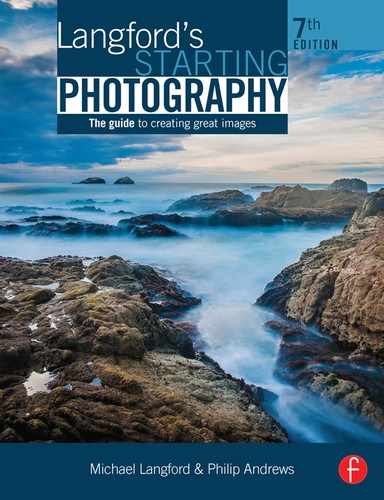Appendix L Using a handheld meter
Modern small-format cameras have a light meter built into the camera to measure the light falling on or reflected by the subject to calculate exposure. But you will not find this feature in older cameras, or in most cameras taking larger formats. You then have to buy a separate, hand-held exposure meter. Used properly this will measure the light and read out the appropriate combination of f-number and shutter speed to set for the film you are using.
A small hand-meter simplifies making local readings of highlight and shadow parts as it is easier to bring near to the subject than moving the whole camera. In fact, you can measure exposure without taking out the camera (an advantage for candid work). However, since the meter does not measure light through the camera lens you must be prepared to adjust the exposure settings it suggests when shooting close-ups.
A traditional hand-meter has a light-sensitive cell at the front to measure the light reflected from your subject. You first set the ISO rating of your film or sensor, point the meter towards the subject and press the button to take a reading. The meter will display a suggested shutter speed and aperture setting of the ISO value and the light in the scene. Often it is possible to display other shutter speed and aperture combinations that will result in the same exposure, given the user the ability to adjust settings to suit aesthetic differences such as blurred movement or depth of field effects.

Figures L.1 Making highlight and shadow readings. (Top) Direct from subject itself. (Above) From substitute hands in direct light and shadow.
Different ways of making readings
Any hand-meter pointed generally at your subject from the camera position will give an exposure reading based on the assumption that the subject has roughly equal areas of light and dark. Some hand-meters have a white plastic diffuser, which slides over the cell. You then hold the meter at the subject, its cell facing the camera, when taking your reading. This ‘incident light’ measurement scrambles all the light reaching parts of the subject seen by the camera, ignoring light or dark unimportant background.
A very accurate way of working is to take two undiffused readings, pointing the meter direct at the darkest important shadowed area, and then at the brightest important highlight area. You then split the difference between the two. For example, for Figure L.1, readings were taken about 15 cm (6 inches) from the lightest and then the darkest parts of the man's head. The camera was then set to exposure settings midway between the two readings.
When a subject cannot be approached so closely try taking readings from nearby substitutes under the same lighting. For example, in Figure L.1 the photographer is reading off the matching skin of his or her own hands – first turned towards, then away from, the same lighting received by the face. In landscapes you can read off the grass at your feet for grass on a distant hill – provided both are under the same lighting conditions. Remember, though, when taking any form of reading, not to accidentally measure your shadow or that of the meter.
Exposure increase for close-ups and filtered images
When you are shooting subjects very close up (using extension rings or bellows to get a sharp image), the image is less bright than with a normal lens setup – even though lighting and f-number remain the same. Inside the camera the effect is like being in a darkened room with a slide projector being moved away from the screen (the film). By extending the bellows you can focus the camera lens for an ever-closer subject, the image becomes bigger but also dimmer.
If your camera measures exposure through the lens itself this change is taken into account by the metering system, but when using a separate meter you must increase the exposure it reads. In practice the increase starts to become significant when you focus on a subject closer than about five times the focal length of the lens you are using, growing greater as you focus on subjects closer still, e.g. something 250 mm from a 50 mm lens needs only 1½ times the normal exposure; at 170 mm it requires twice, and at 100 mm four times the exposure the hand-meter shows. To calculate exposure increase multiply the exposure shown on the meter by (M + 1)2, where M is magnification, meaning height of image divided by height of subject.
For example, photographing a 30 mm high postage stamp so that it appears 12 mm high on the film. As magnification is 0.4 you must multiply exposure by 1.42 which is 2. You can increase exposure either by giving a slower shutter speed, or by opening up the aperture – one f-number for a × 2 increase, one and a half for × 3, and so on.
Adding a filter to the front of your camera also alters the amount of light hitting the film or sensor. Each filter has an associated Filter Factor that indicates the increase in exposure necessary to compensate for this light loss. The easiest way to take into account the filter factor is to multiply the shutter speed by the factor. For example, applying a filter factor of 4 to shutter speed of 1 second would involve multiplying the exposure by 4 giving a new exposure of 4 seconds. Using the same filter but with a shutter speed of 1/60th second would result in an exposure of 4/60th of a second which equals 1/15th of a second.
